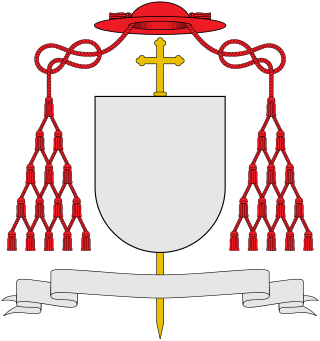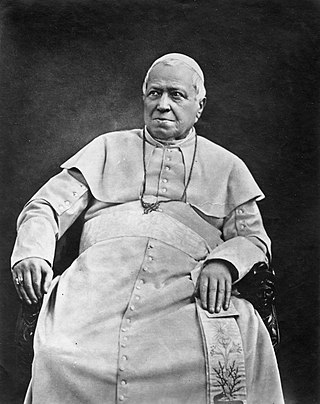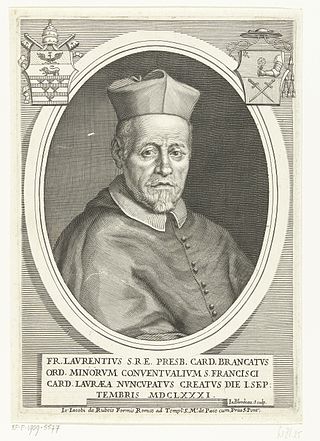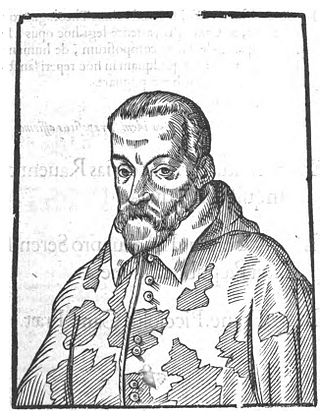This article includes a list of references, related reading, or external links, but its sources remain unclear because it lacks inline citations .(May 2017) |
Romano Bobone (died 1189, Rome) was an Italian cardinal.
This article includes a list of references, related reading, or external links, but its sources remain unclear because it lacks inline citations .(May 2017) |
Romano Bobone (died 1189, Rome) was an Italian cardinal.
His year and place of birth are unknown, but this is presumed to be Rome, where his family was already well-represented in the Roman Curia. He and cardinal Soffredo were made papal legates to Philip II of France and Henry II of England, negotiating a two-year truce between them. On 21 March 1188, pope Clement III made him cardinal deacon of San Giorgio in Velabro. According to Aubery, he moved to a church in Porto.

A cardinal is a senior member of the clergy of the Catholic Church. Cardinals are created by the current pope and typically hold the title for life. Collectively, they constitute the College of Cardinals.

The House of Orsini is an Italian noble family that was one of the most influential princely families in medieval Italy and Renaissance Rome. Members of the Orsini family include five popes: Stephen II (752–757), Paul I (757–767), Celestine III (1191–1198), Nicholas III (1277–1280), and Benedict XIII (1724–1730). In addition, the family included 34 cardinals, numerous condottieri, and other significant political and religious figures.

Pope Celestine III, was the head of the Catholic Church and ruler of the Papal States from 30 March or 10 April 1191 to his death in 1198. He had a tense relationship with several monarchs, including Emperor Henry VI, King Tancred of Sicily, and King Alfonso IX of León.

Pope Victor III, was the head of the Catholic Church and ruler of the Papal States from 24 May 1086 to his death. He was the successor of Pope Gregory VII, yet his pontificate is far less notable than his time as Desiderius, the great abbot of Montecassino.

Pope Innocent XI, born Benedetto Odescalchi, was head of the Catholic Church and ruler of the Papal States from 21 September 1676 to his death on August 12, 1689.
Pope Eugene III, born Bernardo Pignatelli, or possibly Paganelli, called Bernardo da Pisa, was head of the Catholic Church and ruler of the Papal States from 15 February 1145 to his death in 1153. He was the first Cistercian to become pope. In response to the fall of Edessa to the Muslims in 1144, Eugene proclaimed the Second Crusade. The crusade failed to recapture Edessa, which was the first of many failures by the Christians in the crusades to recapture lands won in the First Crusade. He was beatified in 1872 by Pope Pius IX.

Pope Julius II was head of the Catholic Church and ruler of the Papal States from 1503 to his death in February 1513. Nicknamed the Warrior Pope or the Fearsome Pope, he chose his papal name not in honour of Pope Julius I but in emulation of Julius Caesar. One of the most powerful and influential popes, Julius II was a central figure of the High Renaissance and left a significant cultural and political legacy. As a result of his policies during the Italian Wars, the Papal States increased its power and centralization, and the office of the papacy continued to be crucial, diplomatically and politically, during the entirety of the 16th century in Italy and Europe.

Pope Paul II, born Pietro Barbo, was head of the Catholic Church and ruler of the Papal States from 30 August 1464 to his death in July 1471. When his maternal uncle Eugene IV became pope, Barbo switched from training to be a merchant to religious studies. His rise in the Church was relatively rapid. Elected pope in 1464, Paul amassed a great collection of art and antiquities.

Pope Paul IV, born Gian Pietro Carafa was head of the Catholic Church and ruler of the Papal States from 23 May 1555 to his death in August 1559. While serving as papal nuncio in Spain, he developed an anti-Spanish outlook that later coloured his papacy. In response to an invasion of part of the Papal States by Spain during his papacy, he called for a French military intervention. After a defeat of the French and with Spanish troops at the edge of Rome, the Papacy and Spain reached a compromise: French and Spanish forces left the Papal States and the Pope thereafter adopted a neutral stance between France and Spain.

Pope Pius IX was head of the Catholic Church from 1846 to 1878, the longest verified papal reign. He was notable for convoking the First Vatican Council in 1868 and for permanently losing control of the Papal States in 1870 to the Kingdom of Italy. Thereafter, he refused to leave Vatican City, declaring himself a "prisoner of the Vatican".
Alessandro Damasceni Peretti di Montalto was an Italian Catholic Cardinal Bishop. He received the title by his uncle Felice Peretti after the latter was elected Pope Sixtus V on 24 April 1585, in the consistory on 13 May, and was installed as Cardinal Deacon of San Girolamo dei Croati on 14 June 1585; the cardinal was then fourteen years old. The Republic of Venice inscribed him in the Libro d'Oro as a patrician of Venice that same year. Though he was made the permanent governor of Fermo the following year, and was often the papal legate in Bologna, he was not made a bishop until 1620, when he became Cardinal-Bishop of Albano. He served also as Vice-Chancellor of the Holy Roman Church (1589–1623) and Cardinal Protector of the Kingdom of Poland and of the several religious orders.

The Church of Saint Susanna at the Baths of Diocletian is a Roman Catholic parish church located on the Quirinal Hill in Rome, Italy. There has been a titular church associated to its site as far back as AD 280. The current church was rebuilt from 1585 to 1603 for a monastery of Cistercian nuns founded on the site in 1587, which still exists there.

The history of the papacy, the office held by the pope as head of the Catholic Church, spans from the time of Peter, to the present day. Moreover, many of the bishops of Rome in the first three centuries of the Christian era are obscure figures. Most of Peter's successors in the first three centuries following his life suffered martyrdom along with members of their flock in periods of persecution.
Jordan was a Carthusian monk, created Cardinal Deacon by Pope Lucius II in December 1144 and then Cardinal Priest of Santa Susanna by Eugene III on 21 December 1145. He is often referred to as a member of the Roman family of the Orsini, but more recent research concludes that he was probably a Frenchman. He served as Camerlengo of the Holy Roman Church under Eugene III and subscribed the papal bulls between 9 January 1145 and 11 June 1154.

Francesco Lorenzo Brancati di Lauria was an Italian cardinal and theologian.

Luigi d'Este was an Italian Catholic cardinal, the second son of the five children of Ercole II d'Este, Duke of Modena and Ferrara, and Renée, daughter of Louis XII of France.

The 1191 papal election took place after the death of Pope Clement III. Pope Clement, according to differing and irreconcilable reports, died in March 1191, in the last third of the month, on the 20th, the 25th, the 26th, the 28th, or perhaps 2 April or 4 April, or 10 April. The election was conducted during the march of King Henry VI and his army toward Rome. The 85-year-old Cardinal Giacinto Bobone, a member of the Orsini family, was chosen after some extreme reluctance. He took the name Celestine III. Pressed by the Romans, however, he agreed to negotiate with King Henry about his coronation as emperor and about the possession of the city of Tusculum. Celestine postponed his own consecration in order to buy time to negotiate. He was finally crowned on Easter Sunday, 14 April 1191.

Edoardo Menichelli is a prelate of the Roman Catholic Church. He served as Archbishop of the Archdiocese of Ancona-Osimo from 2004 to 2017. Pope Francis made him a cardinal on 14 February 2015.
Soffredo was an Italian cardinal. His name is also given as Soffredo Errico Gaetani, whilst his Christian name is also spelled Soffrido or Goffredo in some sources.

Ascanio Colonna (1560–1608) was an Italian Cardinal who in his lifetime enjoyed a reputation for eloquence and learning.